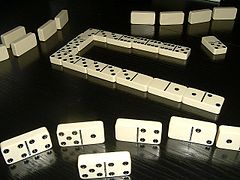Dominoes
 |
|
| Genre(s) | Tile-based game |
|---|---|
| Players | 2 to 4 |
| Playing time | less than 15 minutes |
| Skill(s) required | Tactics, strategy |
Dominoes or dominos is a game played with rectangular "domino" tiles. The domino gaming pieces make up a domino set, sometimes called a deck or pack. The traditional Sino-European domino set consists of 28 dominoes, colloquially nicknamed bones, cards, tiles, tickets, stones, chips, or spinners. Each domino is a rectangular tile with a line dividing its face into two square ends. Each end is marked with a number of spots (also called pips, nips, or dobs) or is blank. The backs of the dominoes in a set are indistinguishable, either blank or having some common design. A domino set is a generic gaming device, similar to playing cards or dice, in that a variety of games can be played with a set.
The earliest mention of dominoes is from Song dynasty China found in the text Former Events in Wulin by Zhou Mi (1232–1298). Modern dominoes first appeared in Italy during the 18th century, but how Chinese dominoes developed into the modern game is unknown. Italian missionaries in China may have brought the game to Europe.
The name "domino" is most likely from the resemblance to a kind of carnival costume worn during the Venetian Carnival, often consisting of a black-hooded robe and a white mask. Contrary to the coinage of the word polyomino as a generalization, there is no connection between the word "domino" and the number 2 in any language.
European-style dominoes are traditionally made of bone or ivory, or a dark hardwood such as ebony, with contrasting black or white pips (inlaid or painted). Alternatively, domino sets have been made from many different natural materials: stone (e.g., marble, granite or soapstone); other hardwoods (e.g., ash, oak, redwood, and cedar); metals (e.g., brass or pewter); ceramic clay, or even frosted glass or crystal. These sets have a more novel look, and the often heavier weight makes them feel more substantial; also, such materials and the resulting products are usually much more expensive than polymer materials.
...
Wikipedia
